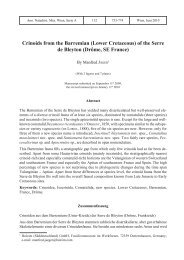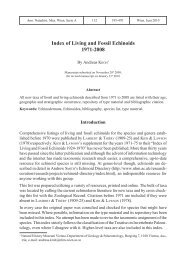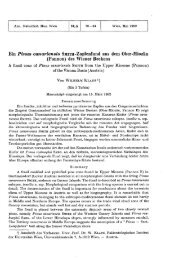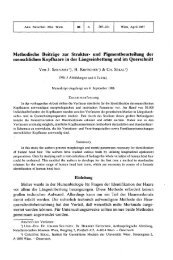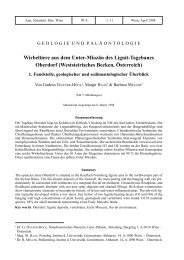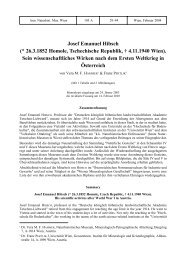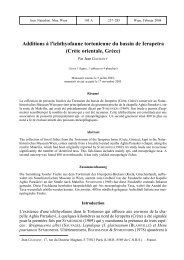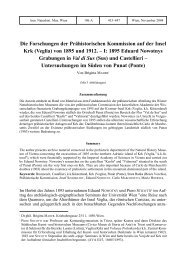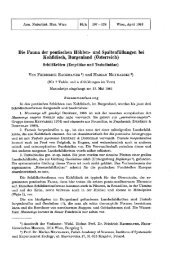An Upper Cretaceous Mollusc Fauna from the Marbles of ...
An Upper Cretaceous Mollusc Fauna from the Marbles of ...
An Upper Cretaceous Mollusc Fauna from the Marbles of ...
You also want an ePaper? Increase the reach of your titles
YUMPU automatically turns print PDFs into web optimized ePapers that Google loves.
112 G. CH. KATSIKATSOS & H. A. KOLLMANN<br />
2. Italoptygmatis geinitzi (GOLDFUSS, 1841-44) which has a large blunt palatal<br />
plait constricting <strong>the</strong> interior <strong>of</strong> <strong>the</strong> whorls to a narrow slit. The synonymous<br />
forms have been listed above.<br />
The specimens <strong>from</strong> <strong>the</strong> marble <strong>of</strong> Almyropotamos probably belong to<br />
Italoptygmatis geinitzi (GOLDFUSS) but due to <strong>the</strong> shell distortion an assignment<br />
can't be made with absolute certainty.<br />
Age: According to <strong>the</strong> authors, Italoptygmatis geinitzi (GOLDFUSS) is restricted<br />
to <strong>the</strong> uppermost lower Cenomanian and <strong>the</strong> upper Cenomanian.<br />
Oligoptyxis sp. PÈELINTSEV 1953<br />
(Plate 1, Figure 8)<br />
Material: 1 Specimen.<br />
Description: High-spired shell with low, more or less convex whorls.<br />
Periphery <strong>of</strong> whorls rounded. Cominella very thick; interior <strong>of</strong> whorls with<br />
moderately concave columellar portion, oblique between parietal and palatal<br />
region. Very small parietal plait in some whorls.<br />
Discussion: Phaneroptyxis is morphologically close, but has always concave<br />
whorls; <strong>the</strong>y are concave, flat or convex in Oligoptyxis PCELINTSEV. One character<br />
which is not visible when <strong>the</strong> shell is recrystallized is <strong>the</strong> columella structure. In<br />
well preserved material a long narrow siphonal channel is indicated by <strong>the</strong> growth<br />
lines. The o<strong>the</strong>r important morphological feature <strong>of</strong> Oligoptyxis is <strong>the</strong> small<br />
parietal plait, which does not occur in Phaneroptyxis.<br />
Stratigraphie and geologic distribution: The genus is known <strong>from</strong> <strong>the</strong><br />
sou<strong>the</strong>rn Soviet Union (HACOBJAN, 1976) and Austria (KOLLMANN 1976). The<br />
stratigraphie distribution is <strong>Upper</strong> Albian to Turonian.<br />
Actaeonella schiosensis BOEHM<br />
(Plate 2, Figure 10-11)<br />
1895 Actaeonella (Volvulina) schiosensis BOEHM, Schiosi- und Calloneghe-<strong>Fauna</strong>, p. 133, pi. 13,<br />
fig. 1-3.<br />
1965 Actaeonella caucasico schiosensis BOEHM-KOLLMANN, Actaeonella, p. 253-255<br />
1971 Trochactaeon obtusus (ZEKELI)-CARBONE, PRATURLON & SIRNA, Rocca di Cave, p. 153, fig. 25<br />
Material: Several sections, cutting plain mostly not through axis or shell<br />
distorted.<br />
Description: Shell involute. Lower portion <strong>of</strong> whorls subcylindrical, maximum<br />
diameter at Ye <strong>of</strong> shell <strong>from</strong> base; distinct shoulder between subcylindrical<br />
and posterior part which has slightly convex sides, sloping towards apical tip.<br />
Strong palatal inflation opposite to angle between columella and parietal region<br />
divides interior <strong>of</strong> whorl in broader lower part and narrow upper part. Columella<br />
high, sides inclined at narrow angle towards axis, bearing three plaits. <strong>Upper</strong>most



